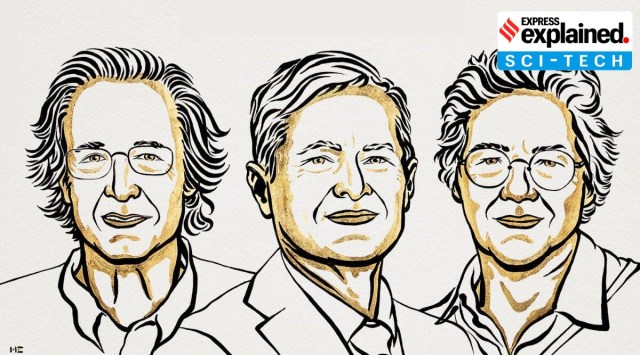Physics Nobel 2023: They made it possible to watch electrons move
Pierre Agostini, Ferenc Krausz and Anne L’Huillier "have given humanity new tools for exploring the world of electrons inside atoms and molecule", the Nobel Committee said.
 Pierre Agostini, Ferenc Krausz and Anne L’Huillier, winners of the 2023 Nobel Prize for Physics, are pictured in this illustration. (Niklas Elmehed / Royal Swedish Academy of Sciences)
Pierre Agostini, Ferenc Krausz and Anne L’Huillier, winners of the 2023 Nobel Prize for Physics, are pictured in this illustration. (Niklas Elmehed / Royal Swedish Academy of Sciences) In our everyday lives, we are familiar with processes that happen so fast we are unable to observe them completely. For example, when a bullet is fired at an apple, we see the outcome — the smashed apple — but are unable to capture the entire process, which takes barely a few milliseconds. With the help of a camera that has a very high shutter-speed, it is possible to see every step of the bullet piercing the apple and coming out of it, destroying the apple in the process.
But there are a lot of other processes in the universe that are incredibly faster, especially at atomic and subatomic levels. Atoms or molecules make movements, or changes, that take just a few picoseconds (a trillionth of a second, or 10-12 seconds) or femtoseconds (10-15 seconds). Scientists found innovative ways to observe these processes, using unimaginably short pulses of light, similar to using extremely high shutter-speed cameras. But then they hit a barrier.
A matter of attoseconds
There were processes that were even faster, happening within a few attoseconds (thousandth of a femtosecond, or 10-18 second) — the motion of electrons within the atom, for instance. For a long time, femtosecond ‘photography’ was considered the limit. Production of shorter pulses of light, in the attosecond range, did not seem possible. Till the works of Pierre Agostini, Ferenc Krausz and Anne L’Huillier made it possible.
The 58-year-old Frenchman Agostini, 61-year-old Hungarian Krausz, and 65-year-old L’Huillier, also French, were on Tuesday awarded the 2023 Nobel Prize in Physics “for experimental methods that generate attosecond pulses of light for the study of electron dynamics in matter”. In the process, L’Huillier became just the fifth woman to win the Physics Nobel.
“This is a fantastic recognition. All the three have produced some wonderful science which can be very transformative. Another person who made tremendous contributions in this field was Paul Corkum, who provided the scientific insight into the experimental data that was being generated by the three winners,” said M Krishnamurthy of the Hyderabad centre of Tata Institute of Fundamental Research, who works in a related field.
Attosecond science
To observe any process, the measurement must be made at a pace quicker than the rate of change. That is how clear images of moving objects are generated: for example, by making the shutter open and close faster than the motion being captured. But there is a limit to how fast the shutter speed can be.
Light pulses, the only plausible tool to capture processes at the atomic level, cannot be made indefinitely shorter. Light consists of waves, or vibrations in the electromagnetic field. The shortest possible pulse would have to be at least one cycle long, equivalent to its wavelength. For all sorts of light produced by laser systems, this cycle used to take at least a few femtoseconds to complete. This was longer than the sub-atomic motion that was happening in a matter of attoseconds. Scientists were therefore unable to glimpse the motion of electrons with existing technologies.
“Femtosecond pulses had enabled scientists to observe the processes happening at the atomic or molecular level. But when one moves further down, at the sub-atomic level, things start to happen even faster. The dynamics of the electron, for example, are 100 to 1,000 times faster than that of the atom. A lot of that has to do with inertia. The atom is heavier, because of the nucleus, and has greater inertia. Lower the inertia, faster the dynamics,” said Sivarama Krishnan, an associate professor at IIT Madras, who uses femtosecond and attosecond light pulses to study the dynamics in nano-scale systems.
Working independently, Agostini, Krausz and L’Huillier developed innovative methods, usually by mixing lights of different wavelengths, to produce attosecond pulses, which, the Nobel Prize committee said, “opens windows… to explore phenomena that were previously impossible to observe”.
Watching electron dynamics
It is natural for scientists to try and observe every step of a process, so they can fully understand it. More importantly, it allows scientists to control the process by tweaking the intermediate steps and obtaining desired results.
As Krishnan said, “Scientists are interested not just in watching the film, they would also like to script the next film.”
In fact, this is the third Nobel Prize in this field in the last three decades, underscoring the potential benefits of the science. The 1998 Nobel Prize in Chemistry to Egyptian scientist Ahmed Zewail, and the 2018 Nobel Prize for Physics to Gerard Mourou, Donna Strickland and Arthur Ashkin, were for breakthroughs in related science.
Potential uses
Attosecond science has potential applications in a variety of areas, from electronics to medicine, across disciplines in physics, chemistry and biology.
“One of the active areas of research using this technology is in medical science, particularly in finding therapies for cancer care,” said Kamal P Singh of IISER Mohali, who too works with femtosecond lasers.
- 01
- 02
- 03
- 04
- 05






































